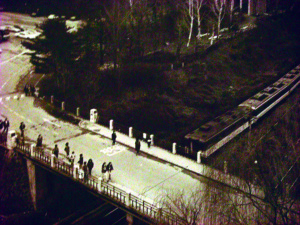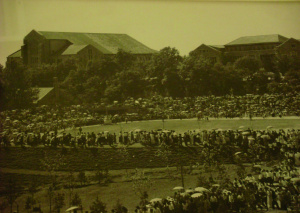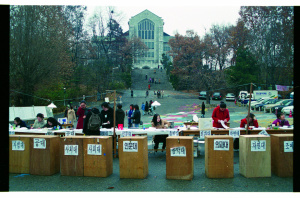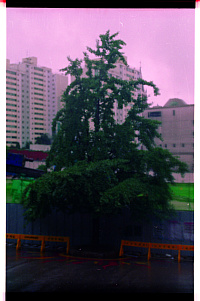More than 50 buildings cover the Ewha campus in Shinchon. Some, such as the Welch Ryang Auditorium and Pfeiffer Hall, have stood for decades. Others fill ground once occupied by facilities that no longer exist today.
A total of nine once-important Ewha landmarks have faded away since the campus was constructed in 1935. Three stands out as the most memorable places for Ewha alumnae: the Ewha Bridge, the Schoolyard and a tree named Shin-dan-soo.
The Ewha Bridge was just outside of the Main Gate, which was then made of green, painted metal. It was 60 meters long and 10 meters wide.
“The Ewha Bridge was more than just an entrance to Ewha,” Park Jung-hye (’93, Clothing and Textiles) said. “It was a symbol of entering Ewha.”

A small square made of asphalt right in front of the Ewha Bridge was called the “Babo Stage,” Babo meaning “fool” in Korean. “Boyfriends of Ewha students used to wait in front of the Ewha Bridge due to rumors that males were not allowed to enter the women’s school, at all,” Park said. The bridge was named after these boyfriends.
The Ewha Bridge disappeared in 2002 when construction covered up the railroad that ran beneath it, according to the Ewha Archives.
“Most of my friends would miss the Ewha Bridge the most,” Park said. “With the bridge gone, the feeling of peacefulness is no longer there since the border between the school and the business district has broken down.”
Once across the Ewha Bridge, students and visitors entered the Schoolyard of Ewha, which was done away when construction began on the Ewha Campus Complex in 2005.
Although the Schoolyard of Ewha, built in 1958, is recorded as the first schoolyard made of grass, many Ewha graduates remember it as a yard filled with rough sand.
“I remember watching golf lessons at the Schoolyard where golf clubs would make mini-sand storms every time a student took a swing,” Son Ki-eun (’07, Mass Communications) said. “There used to be a short tunnel that led into the Schoolyard that was full of wall paintings by Ewha students.”

Surrounding the Schoolyard was a long line of large trees that also disappeared in 2002.
“Students would hang large hand-written posters in between the trees,” Park said. “These were to notify Ewha students about important events or student movements going on in the campus.”

In the middle of the Ewha Square, where one would stand to look over the Schoolyard, was the Shin-dan-soo, the beloved tree of Ewha.
“The name Shin-dan-soo seems to have come from the Dangun mythology,” said Son hyun-ji (’01, History), who is now a researcher at the Ewha Archives. “I’m not sure why, but students just called it that.”
The Dangun mythology is the story of Dangun Wanggeom who is the legendary founder of Gojoseon, the first Korean kingdom
“Before climbing the stairs up to Welch-Ryang Auditorium to attend the chapel, I would stop in the shade of the Shin-dan-soo to take a deep breath,” Son said.
The Shin-dan-soo was removed in 2009 due to the construction of the ECC.

The Ewha campus map has evolved through the years in many good ways. Facilities have increased and become more convenient. But behind the development was the demise of heartrending, old Ewha landmarks. Although mostly forgotten to yearly Ewha newcomers, the lapsed milestones remain in the hearts of many Ewha graduates.

